The dimensions of a guitar neck are critical factors influencing playability and comfort for various hand sizes and playing styles. These dimensions typically include width, length, and profile shape, with the width usually measured at the nut.
On acoustic guitars, common nut widths range from 41mm (1.61″) to 47mm (1.85″), while electric guitars typically have nut widths between 41mm (1.61″) to 44mm (1.73″).
The neck profile shape, such as C, D, U, or V, significantly impacts how the neck feels in a player’s hand and can affect playing speed and comfort. Scale length, which is the overall length of the guitar neck, and fretboard radius are also important dimensions that influence string tension, tone, and the ease of playing certain techniques.
Key Takeaways:
- Guitar neck dimensions, including width, length, and profile shape, significantly influence an instrument’s playability and comfort for different hand sizes and playing styles.
- Typical guitar neck widths range from 41mm to 47mm at the nut, with 44mm being a common standard for many players.
- Neck shapes, such as C, D, U, and V profiles, affect grip and playability, with wider and rounder shapes often preferred by those with larger hands and narrower, flatter profiles suiting smaller hands.
- The scale length (overall length of the guitar neck) and fretboard radius are important dimensions that can affect the ease of playing certain styles of music.
- Custom guitar necks allow players to choose specific dimensions, wood types, and features to create an instrument tailored to their unique preferences and needs.
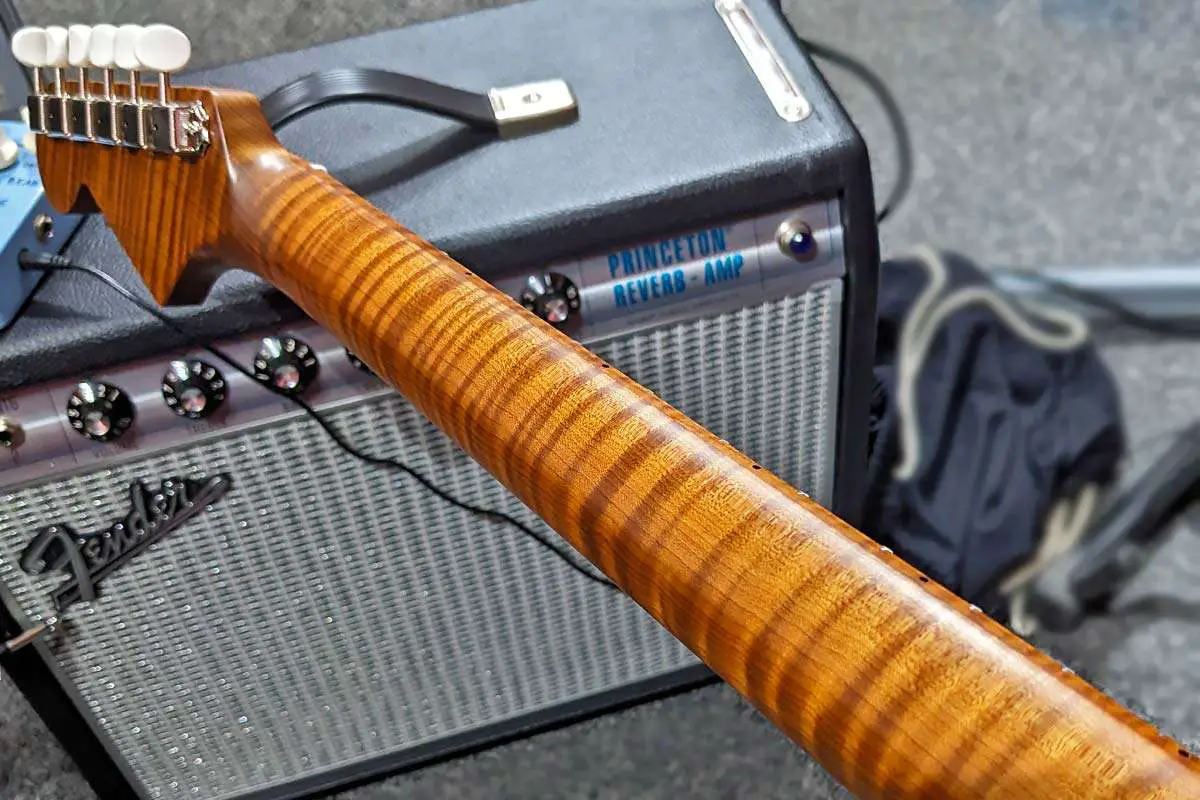
Fundamentals of Guitar Necks
Guitar necks are central to playability and comfort. They vary by length, width, materials used, and overall shape, each contributing to the instrument’s feel and sound.
Neck Dimensions
The length of your guitar neck usually refers to the scale length, which is the distance from the nut to the bridge. Width is typically measured at the nut, and the depth of the neck can vary, often provided at the first and twelfth frets to give an idea of its tapering. Here’s a table summarizing typical neck dimensions for electric and acoustic guitars:
| Guitar Type | Scale Length | Nut Width |
|---|---|---|
| Electric | 25.5″ (64.8 cm) | 1.65-1.69″ (42-43 mm) |
| Acoustic | 24.75-25.5″ (62.9-64.8 cm) | 1.69-1.75″ (43-44.5 mm) |
These measurements can vary depending on the specific model and manufacturer. The neck depth is not included in the table as it significantly varies across different guitar models and brands. Always check the specifications of the particular guitar you’re interested in for the most accurate measurements.
Related: What Is A Multiscale Guitar
Material and Build
Your guitar’s neck is often constructed from hardwoods like maple or mahogany, with rosewood or ebony commonly used for the fretboard. The neck’s material and build quality influence the instrument’s stability and resonance.
Neck Shapes
Neck shapes, referred to as the profile, can significantly affect comfort. Popular shapes include the “C” shape which is comfortable for most hand sizes, and the “V” shape that can be either soft or sharp. The fretboard radius—how flat or curved the fretboard is—impacts playability, with a flatter radius being suited to bending notes and a more curved radius assisting in chord playing.
Anatomy of a Guitar Neck
The precise dimensions of your guitar’s neck greatly influence playability. Understanding the nut width, fretboard radius, and the neck size and depth will help you find a comfortable fit for your playing style.
Nut Width
The nut width refers to the width of the guitar neck at the nut. This is the end closest to the headstock where the frets begin. Standard nut widths range from approximately 1.650 inches (42mm) to 1.875 inches (48mm). The width at the nut determines the spacing between strings and can affect the ease of playing certain chord shapes.
- 1.650″ (42mm): Often found on electric guitars.
- 1.6875″ (43mm): Common for acoustic guitars.
- 1.875″ (48mm): A wider option for classical guitars.
Fretboard Radius
Moving to the fretboard radius, this term describes how flat or curved the fretboard is across its width. Measured in inches, the radius can vary from a nearly flat 20″ to a much more curved 7.25″. Flatter radii facilitate bending notes without fretting out, while more curved fretboards are often considered more comfortable for playing chords.
- 7.25″-9.5″: Vintage or vintage reissue models.
- 10″-16″: Modern electrics and acoustics.
- Compound radius: Gradually flattens from nut to the higher frets.
Neck Size and Depth
Finally, neck size and depth are key to the neck profile, which can be described as C, U, or V shaped. Beyond profile, the actual measurements at the first fret and the twelfth fret are indicators of the neck dimension.
| Neck Profile Shape | Distinct Characteristics | Playing Characteristics |
|---|---|---|
| C Shape | Curved, comfortable profile that fits naturally in the hand. It’s the most common and widely used shape. | Versatile and suitable for most playing styles. It provides a comfortable grip for both chord playing and single-note runs. |
| U Shape | Thicker and rounder than the C shape, resembling a “U”. Sometimes referred to as a “baseball bat” profile. | Provides substantial support for the hand, favored by players seeking a fuller grip. Can be tiring for some due to its size. |
| V Shape | Features a sharper, more pronounced “V” shape, often preferred by players who use their thumb over the neck. | Offers a distinct grip that some find enhances thumb-over techniques. Can be less comfortable for players with smaller hands. |
Each neck profile shape caters to different preferences and playing styles. The C shape is known for its universality and comfort, making it a popular choice for many guitarists. The V shape can be more specialized, often chosen by players who have a specific playing style that benefits from the unique contour of the neck. The U shape is for those who prefer a chunkier neck to hold onto, which can be particularly beneficial for certain genres like blues or players who are used to vintage-style necks.
Neck Shape Variations
When selecting a guitar, the shape of the neck is a critical factor that affects playability and comfort. There are a variety of neck shapes to suit different playing styles and hand sizes.
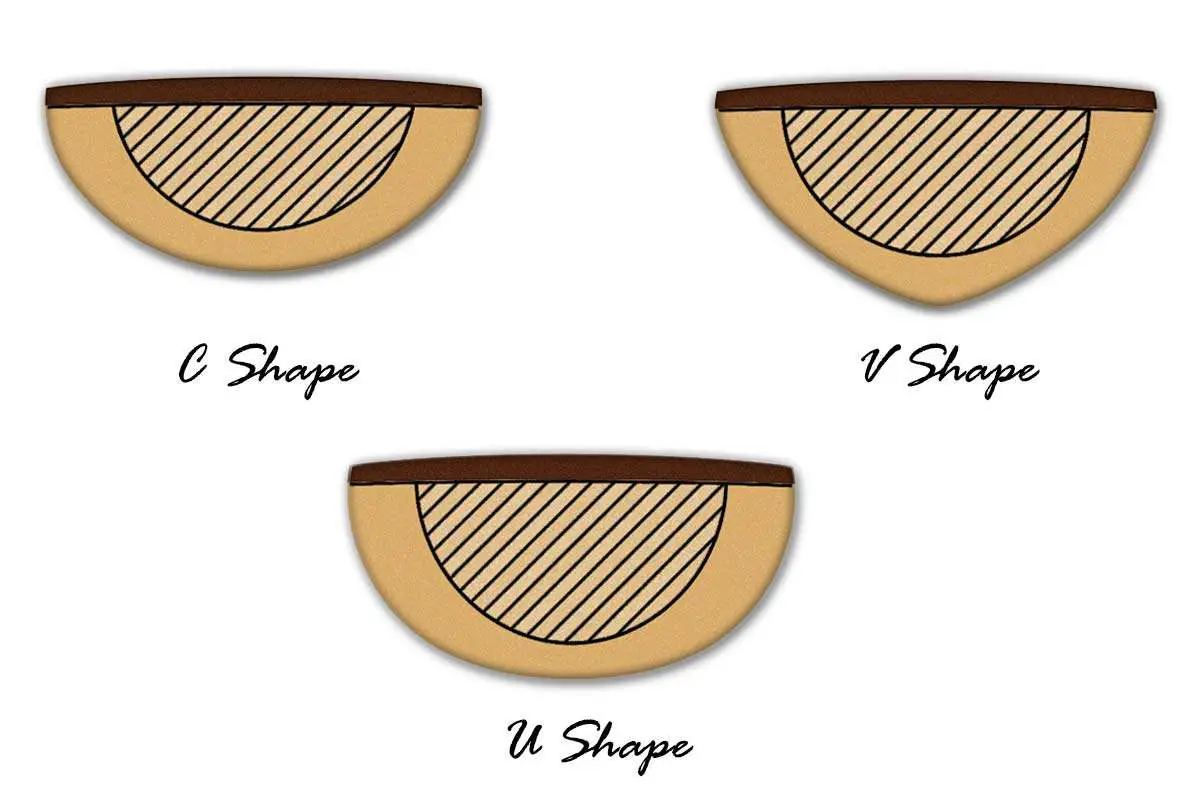
Common Neck Shapes
The C shape neck is most prevalent and recognized for its comfort. It’s suitable for a wide range of hand sizes and playing styles. The U shape is a thicker option, reminiscent of vintage guitars, and can be more suitable for players with larger hands or those who prefer a substantial grip. A V shape neck can provide a distinctive feel, with some players finding it more ergonomic for thumb-over playing.
Specialized Neck Shapes
Beyond the standard shapes, there are specialized profiles like the D shape, which offers a flatter back and is often preferred for faster playing due to its thinner profile. The modern flat oval combines comfort with a design conducive to swift movement along the fretboard. These specialized shapes may cater to specific playstyles and ergonomic requirements.
Choosing the Right Neck Shape
When deciding on a guitar neck shape, it’s important to consider these factors in conjunction with each other to find the most suitable option. Trying out different neck shapes and getting a feel for how they fit with your hand size, playing style, and preferences is the best way to determine the right choice for you.
| Factor to Consider | Description | Why It’s Important |
|---|---|---|
| Hand Size | The size of the player’s hand can greatly affect comfort and playability. | Ensures that the neck does not cause strain or discomfort during play. |
| Playing Style | Different playing styles may benefit from different neck shapes. | A neck shape that matches the player’s style can enhance playability and technique. |
| Genre of Music | Certain genres may be associated with specific neck profiles due to common techniques or historical preferences. | The right neck shape can facilitate the typical playing techniques of a genre. |
| Comfort | Overall comfort while playing should be a primary concern, as it can affect performance and endurance. | A comfortable neck shape can prevent fatigue and improve the quality of playing. |
| Personal Preference | Subjective feel and the player’s unique preference play a significant role in neck shape choice. | The player’s satisfaction with the neck shape can influence their connection to the guitar. |
| Adaptability | Some neck shapes are more adaptable to various playing techniques and hand positions. | A versatile neck shape can accommodate growth and changes in playing style over time. |
| Experience Level | Beginners might prefer a more universally comfortable neck, while experienced players may have more specific tastes. | A neck shape that suits the player’s experience level can make learning and playing easier. |
Guitar Neck Specifications
Understanding the exact dimensions of your guitar neck is crucial for both playability and comfort. Specific measurements, such as neck width and depth, can greatly influence your playing style and technique.
Measurements and Sizing
When you’re considering neck dimensions, you measure neck width at the nut, which is the zero fret and the interface between the headstock and the fretboard. For most guitars, this width can vary significantly, typically ranging from 41 millimeters (mm) in some narrower models to 44 mm or more in wider designs. Neck depth is measured with calipers, offering an insight into the neck’s profile from the front of the nut to the apex of the neck’s curvature.
To accommodate different preferences and hand sizes, manufacturers like Fender, Gibson, PRS, and Ibanez design a variety of neck shapes such as the ‘C’, ‘U’, ‘V’, and ‘D’ profiles. These profiles outline the rear contour of the neck as it transitions from the headstock to the body, influencing how the neck feels in your hand.
Common Measurements by Brand
- Fender: Fender necks typically feature a neck width at the nut around 42 mm, with shapes varying from the slim ‘Modern C’ to the thicker ‘U’-shaped necks found in vintage models.
- Gibson: Gibson, on the other hand, often opts for a slightly wider nut width, usually close to 43 mm, notorious for their ’50s-style rounded neck profile, as well as the slimmer ’60s taper.
- Ibanez: Ibanez guitars are generally known for their thin Wizard necks, which are extremely comfortable for players who prefer a fast-playing neck, often measuring a neck width at the nut of 43 mm but with shallower depths.
- PRS: PRS guitars blend traditional and modern styles, commonly applying a width of 42 mm at the nut and offering various profiles from wide-fat to wide-thin, catering to diverse playing preferences.
- Epiphone: As Gibson’s subsidiary, Epiphone often mirrors Gibson’s neck dimensions but maintains slightly varied specs in models like the Epiphone Les Paul or SG with nut widths usually close to that of Gibson.
Note: Always verify specific measurements with the manufacturer or measure the guitar yourself using calipers, as models and specifications can vary.
Ergonomics and Playability
Your experience with a guitar heavily depends on the ergonomics of the neck which directly affects its playability. The shape and dimensions of the neck influence your hand comfort and can either enhance or hinder your playing style.
Hand Comfort and Playability
The contour of a guitar neck should fit comfortably in your hand, allowing for a natural and relaxed grip. A proper neck shape lets your thumb rest adequately, supporting various hand positions that are necessary for playing different chords and scales. Choosing a neck that fits your hand size and shape is vital for maintaining speed and precision. A neck that’s too wide or thick can make it difficult for your fingers to reach certain frets, while a neck that’s too thin might not provide enough support for your hand, leading to muscle fatigue.
Impact on Playing Style
The guitar neck profile directly affects your ability to play smoothly and quickly. A slimmer neck allows for faster playing, facilitating rapid position changes and techniques like shredding. Conversely, some players may find that a chunkier neck better suits rhythm playing or the utilization of thumb-over techniques. Your choice in neck profile should complement your playing style whether you’re aiming for deft lead lines or the solid strumming of chords.
When assessing a guitar neck for ergonomic comfort and playability, it’s essential to consider these aspects in relation to your unique hands and playing approach.
Historical and Cultural Context
The dimensions of guitar necks have evolved based on the needs of players and the prevailing music styles of different eras. As a guitarist, understanding the historical and cultural context can give you a deeper appreciation of your instrument’s design.
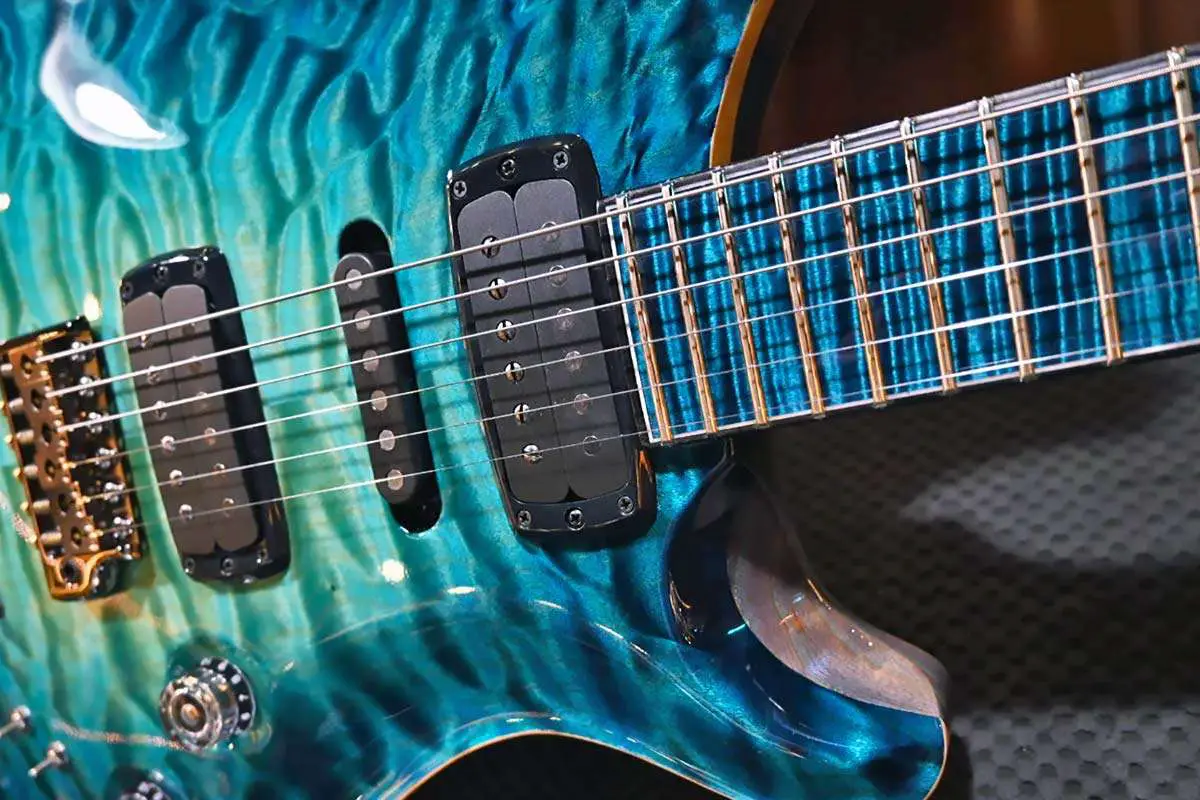
Evolution of Guitar Necks
The guitar as an instrument has seen a multitude of changes over the centuries, particularly in the design and dimensions of the neck. In the 19th century, Antonio de Torres Jurado revolutionized the guitar with innovations that established the standards for modern classical guitars. His designs included a widening of the neck, which provided a foundation for the various neck shapes we see today in both acoustic guitars and electric guitars.
Through the 20th century, as music styles evolved from blues to rock and roll, so did the guitar neck. Fender and Gibson, two prominent guitar manufacturers, introduced their own iconic designs: the Fender guitar, known for its “C” shaped neck, and the Gibson Les Paul, whose neck profile often provides comfort and fast action for different playing styles.
Notable Guitar Neck Designs
In the realm of electric guitars, notable artists have often teamed up with manufacturers to create signature models that cater to specific playstyles. For example, Eric Clapton’s partnership with Fender led to the development of his signature Stratocaster, which comes with a unique “soft V”-shaped neck designed to fit the hand comfortably. The Brad Paisley Signature Telecaster is another illustration, designed for the modern country guitarist, with a custom “Enhanced V”-shaped neck that accommodates hybrid picking and bends peculiar to Paisley’s playing style.
Acoustic guitars generally maintain wider necks, a tradition originating from classical guitars — this allows for clear fingerpicking and complex chord voicing. The designs reflect the musical demands of the era in which they were developed, as well as the cultural influences of the guitarists who played them.
Practical Considerations
When you’re shopping for a guitar, the dimensions of the neck can greatly affect both playability and comfort. The neck’s width, thickness, profile, and the material it’s made from are crucial factors to consider, whether you’re eyeing an electric guitar or an acoustic.
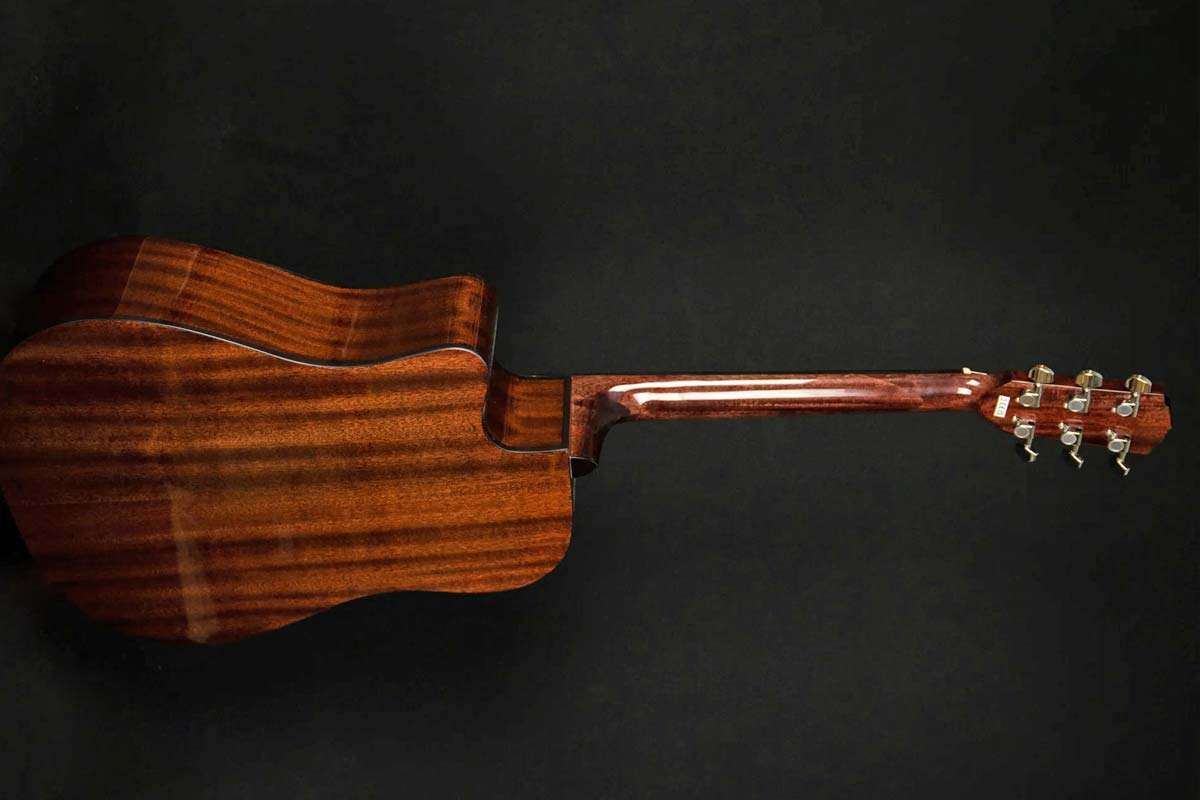
Selecting a Guitar Neck
Electric guitars such as the Stratocaster or Telecaster often have slimmer necks that facilitate quick playing and easier grip for barre chords. Acoustic guitars, on the other hand, can have wider necks that are preferred for fingerstyle playing. Choosing a neck with the right curve and thickness—whether it’s chunky or slim—should be based on the size of your hands and your playing style. The feel of the front of the neck can vary between a smooth maple or a denser ebony fretboard, each offering a distinct tactile experience and tone.
- Neck Dimensions: Standard neck widths are typically around 1-11/16 inches for most electric and acoustic guitars. For a bit more width, some may prefer 1-3/4 inches which is commonly used for playing fingerstyle. Classical guitars have wider necks, approximately 2 inches or around 52mm for a comfortable fit in hand.
- Back Shape: The back shape of the neck can vary—some have a ‘C’ shape which is quite common and comfortable, while others may prefer a ‘V’ or ‘U’ shape for a different feel.
- Fretboard: A flat fretboard can make playing barre chords easier, especially on wider necks, while a curved fretboard might be more comfortable for playing lead guitar on slimmer necks.
Customization and Modification
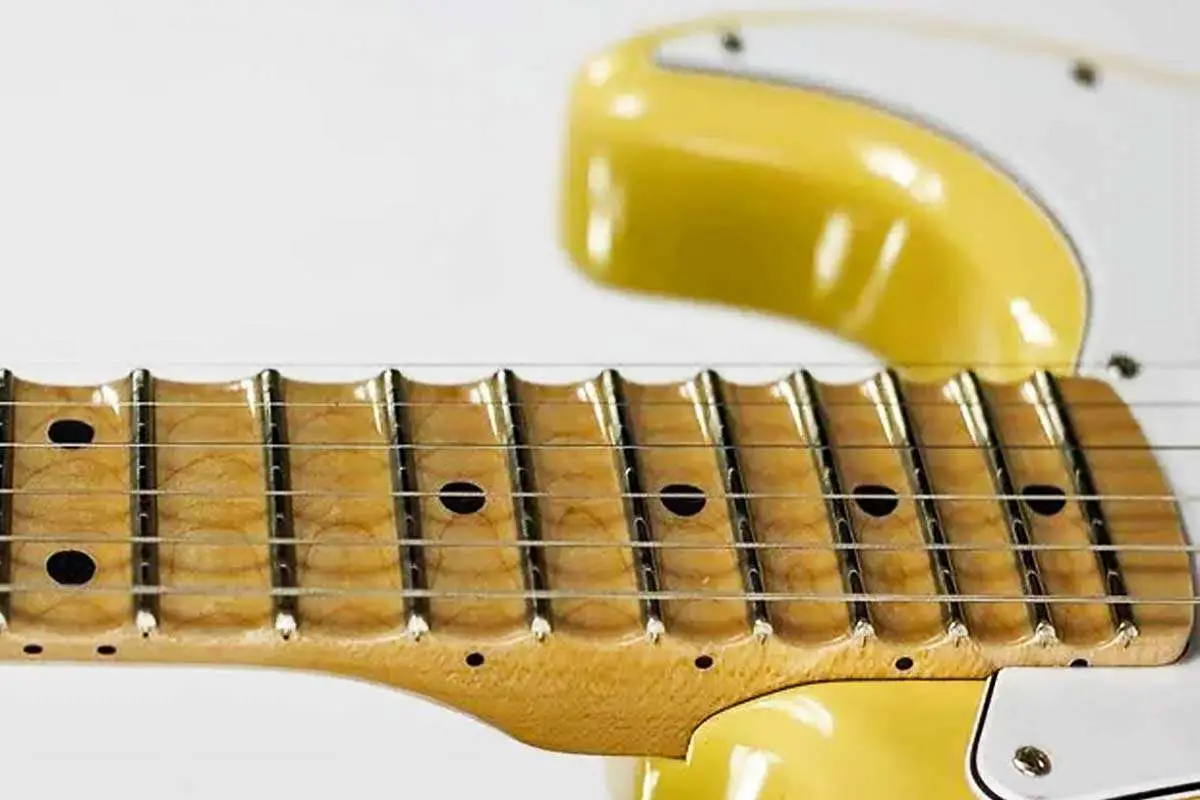
Custom Guitar Necks
When it comes to creating a guitar neck that fits your unique needs, customization plays a fundamental role. Custom guitar necks allow you to choose the exact dimensions, wood type, nut width, and fret size to match your playing style. For instance, should your preference align with the sleekness required for fast playing, a thinner neck with a flatter radius would be optimal. Designing your own guitar neck is an option if you seek a particular shape and feel, ensuring that your instrument is a perfect extension of your musical intent.
- Specifications for Customization:
- Neck Dimension: typically varies from 24 to 25.5 inches
- Wood Type: choose based on tone preference; options include maple, rosewood, mahogany, etc.
- Nut Width: standard sizes range from 1-11/16″ to 1-3/4″
- Fret Size: from narrow vintage-style to jumbo frets for modern playability
Adjustments and Repairs
Your guitar neck might require adjustments for better playability or repairs due to damage or wear over time. Actions such as truss rod adjustment ensure the neck curvature is ideal for your playing comfort. Repairing a damaged neck or worn frets can bring new life to your instrument—be it a treasured vintage piece or a versatile modern axe. For detailed guidance on adjustments, you can visit pages like Warmoth Guitar Products for more insights on custom options and what adjustments might be suitable for your guitar neck.
Common Adjustments:
- Truss Rod: Adjusts neck bowing
- Nut Replacement: Alters string height and spacing
- Refretting: Revitalizes playability
Repair Considerations:
- Scope of Damage: Carefully assess to plan the repair
- Originality vs. Playability: Decide whether to maintain a vintage guitar’s original parts or update them for better performance
- Expertise: Seek a professional for complex repairs to ensure the preservation of your guitar’s quality and sound
